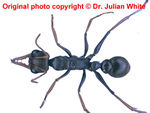|
Myrmecia pilosula
|
![Myrmecia pilosula (Jumper ant, jack jumper) [ Original photo copyright © Dr Julian White ]](images/other_life/TIP00031.jpg)
|
|
Phylum: Arthropoda
|
|
Class: Insecta
|
|
SubClass: Hymenopteroidea
|
|
Genus: Myrmecia
|
|
Species: pilosula
|
Common Names
Jumper ant , Jack jumper
|
Region
Australia
|
Countries
Australia
|
|

|
|
|
|
Taxonomy and Biology
|
Description
Moderate to large ant, total body length about 13 mm, well developed mandibles, sting in abdomen.
|
|
|
|
Venom
|
General: Venom Neurotoxins
Not present
|
General: Venom Myotoxins
Not present
|
General: Venom Procoagulants
Not present
|
General: Venom Anticoagulants
Not present
|
General: Venom Haemorrhagins
Not present
|
General: Venom Nephrotoxins
Not present
|
General: Venom Cardiotoxins
Not present
|
General: Venom Necrotoxins
Probably not present
|
General: Venom Other
Histamine, dopamine, norepinephrine, amino acids, oligopeptides, phospholipids, carbohydrates, melittin, apamin, mast cell degranulating peptide, secapin, tertiapin, protease inhibitor, procamine A&B, phospholipase A&B, hyaluronidases, acid phosphomonoesterase, alpha-D-glucosidase
|
|
|
|
Clinical Effects
|
General: Dangerousness
Severe envenoming only possible with high numbers of stings, at least >50. In adults usually requires >300 stings.
|
|
General: Rate of Envenoming: All stings cause local envenoming
|
|
General: Untreated Lethality Rate: Except in individuals with severe sensitivity to the venom, lethality rate is almost zero in single or small numbers of stings.
|
General: Local Effects
Local pain & swelling, sometimes local blistering, rarely ulceration
|
General: Local Necrosis
Rare, localised only
|
General: General Systemic Effects
General systemic effects unlikely, except with severe allergy or high numbers of stings
|
General: Neurotoxic Paralysis
Does not occur, based on current clinical evidence
|
General: Myotoxicity
Does not occur, based on current clinical evidence
|
General: Coagulopathy & Haemorrhages
Very rare, associated with either anaphylactic shock and secondary DIC, or direct venom toxicity from large numbers of stings, again secondary shock and DIC.
|
General: Renal Damage
Rare, secondary effect of anaphylactic shock or direct venom toxicity from large numbers of stings
|
General: Cardiotoxicity
Does not occur, based on current clinical evidence
|
General: Other
Rarely haemolysis, following massive envenoming by large numbers of stings
|
|
|
|
First Aid
|
|
Description: First aid for Ant Stings (Australian stinging ants; inch ants, jumping ants, jack jumper ant)
|
Details
1. Apply a cold pack to the sting area.
2. If the patient develops generalised rash, difficulty breathing or becomes faint or collapses, urgent treatment is required, as this is an acute allergic reaction (anaphylaxis) to the venom. If there is any impairment of vital functions, such as problems with respiration, airway, circulation, heart function, these must be supported as a priority. In particular, both airway and respiration may be impaired, requiring urgent and prolonged treatment, which may include the mouth to mask (mouth to mouth) technique of expired air transfer. Seek urgent medical attention.
3. If the victim is already known to have an allergy to insect venom (bee or wasp), they are at risk of a major allergic reaction. At the first sign of such a reaction, if available, administer epinephrine (adrenaline, "epipen") as instructed on the medication. If the reaction includes airway constriction (asthma) and a "ventolin" puffer is available, use it. Seek urgent medical attention.
|
|
|
|
Treatment
|
Treatment Summary
Australian jumper & inch ants can sting as well as bite. The sting causes local pain, swelling, sometimes infection and ulceration, but not systemic envenoming.
|
Key Diagnostic Features
Local pain, swelling; in allergic cases, potentially anaphylaxis
|
General Approach to Management
Most cases will develop local effects only, predominantly pain & swelling, requiring local treatment. A few patients develop major allergy and may present with systemic allergic reactions, including anaphylaxis, requiring full resuscitation. All cases developing even mild systemic allergic reactions should be referred to an immunologist allergist for advice, determination of allergic risk and provision of emergency training and adrenaline.
|
Antivenom Therapy
No antivenom available
|
|
|
|
Images
|

|
|
|
|
|
|
|
Myrmecia pilosula (Jumper ant, jack jumper) [ Original photo copyright © Dr Julian White ]
|
|
|
|
|
|
|
|
|



